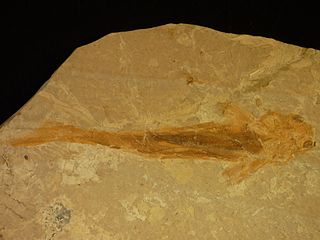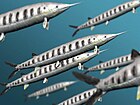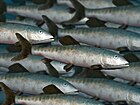
The mojarras are a family, Gerreidae, of fish in the order Perciformes. The family includes about 53 species found worldwide in tropical and warm temperate regions. They mostly inhabit coastal salt and brackish waters, although some occur in fresh water.

Medusafishes are a family, Centrolophidae, of percomorph fishes. The family includes about 31 species. They are found in temperate and tropical waters throughout the world.

Oplegnathus is currently the sole recognized genus in the knifejaw family (Oplegnathidae) of marine perciform fishes. The largest, the Cape knifejaw, can reach a maximum length around 90 cm (35 in). Knifejaws have teeth fused into a parrot-like beak in adulthood. They feed on barnacles and mollusks, and are fished commercially. They are native to the Indian and Pacific Oceans.

Dasyatis is a genus of stingray in the family Dasyatidae that is native to the Atlantic, including the Mediterranean. In a 2016 taxonomic revision, many of the species formerly assigned to Dasyatis were reassigned to other genera.

Aetobatus is a genus of eagle rays native to the Atlantic, Pacific and Indian Oceans. It was formerly placed in Myliobatidae, but is now placed in its own family based on salient differences from myliobatids, especially the pectoral fins joining the head at the level of the eyes.

Leptolepidae is an extinct family of herring-like stem-teleost fish found throughout the world during the Jurassic. They were among the first fish to possess certain teleost synapomorphies, such as cycloid scales and fully ossified vertebrae.
Paleontology or palaeontology is the study of prehistoric life forms on Earth through the examination of plant and animal fossils. This includes the study of body fossils, tracks (ichnites), burrows, cast-off parts, fossilised feces (coprolites), palynomorphs and chemical residues. Because humans have encountered fossils for millennia, paleontology has a long history both before and after becoming formalized as a science. This article records significant discoveries and events related to paleontology that occurred or were published in the year 1973.
Paleontology or palaeontology is the study of prehistoric life forms on Earth through the examination of plant and animal fossils. This includes the study of body fossils, tracks (ichnites), burrows, cast-off parts, fossilised feces (coprolites), palynomorphs and chemical residues. Because humans have encountered fossils for millennia, paleontology has a long history both before and after becoming formalized as a science. This article records significant discoveries and events related to paleontology that occurred or were published in the year 1907.
Paleontology or palaeontology is the study of prehistoric life forms on Earth through the examination of plant and animal fossils. This includes the study of body fossils, tracks (ichnites), burrows, cast-off parts, fossilised feces (coprolites), palynomorphs and chemical residues. Because humans have encountered fossils for millennia, paleontology has a long history both before and after becoming formalized as a science. This article records significant discoveries and events related to paleontology that occurred or were published in the year 1941.
Chongichthys is an extinct genus of prehistoric bony fish that lived during the Oxfordian stage of the Late Jurassic epoch. Fossils of the genus have been found in the Quebrada El Profeta of Chile.
Luisiella is an extinct genus of prehistoric bony fish that lived during the Kimmeridgian stage of the Late Jurassic epoch. Fossils of the genus have been found in either the Cañadón Calcáreo Formation or Cañadón Asfalto Formation in Chubut Province, Argentina.

Australosomus is an extinct genus of prehistoric ray-finned fish that lived during the Early Triassic epoch.
Austropleuropholis is an extinct genus of ray-finned fish that lived during the early Toarcian stage of the Early Jurassic epoch.
Egertonia is an extinct genus of prehistoric bony fish. The earliest occurrences of the genus in the fossil record are from the Late Cretaceous of Madagascar and India.
Orvikuina is an extinct genus of prehistoric bony fish.

Pholidorhynchodon is an extinct genus of ray-finned fish that lived in the Triassic. Its fossils have been found in Italy, in the Zorzino Limestone Formation in Cene.
Pleuropholis is an extinct genus of prehistoric ray-finned fish.

Peipiaosteus is an extinct genus of prehistoric chondrostean ray-finned fish. Its fossils are found in the Early Cretaceous Jiufotang Formation, Pani Lake, Liaoning Province, China.

Tarasiiformes is an extinct order of prehistoric ray-finned fish.

Myllokunmingiidae is a group of very early, jawless prehistoric fish (Agnathans) which lived during the Cambrian period. The Myllokunmingiids are the earliest known group of craniates. The group contains three genera, Haikouichthys, Myllokunmingia, and Zhongjianichthys. Their fossils have been found only in the Maotianshan Shales lagerstätte.

















